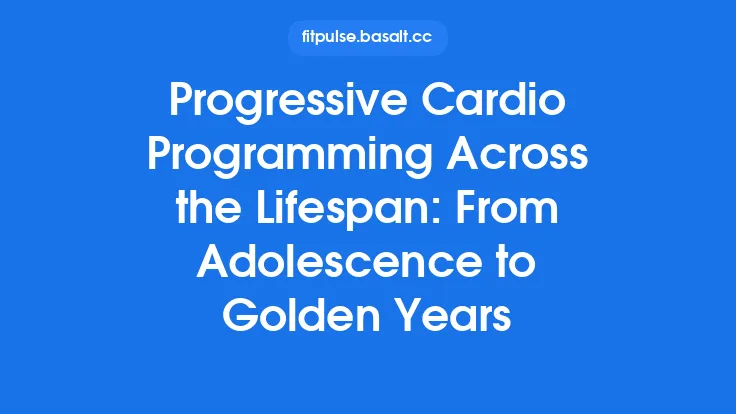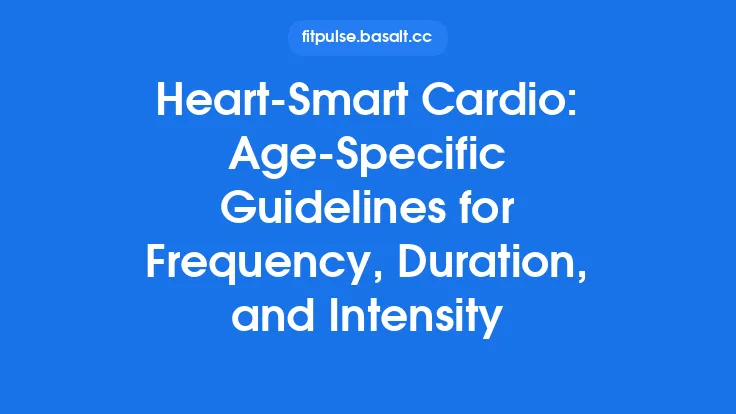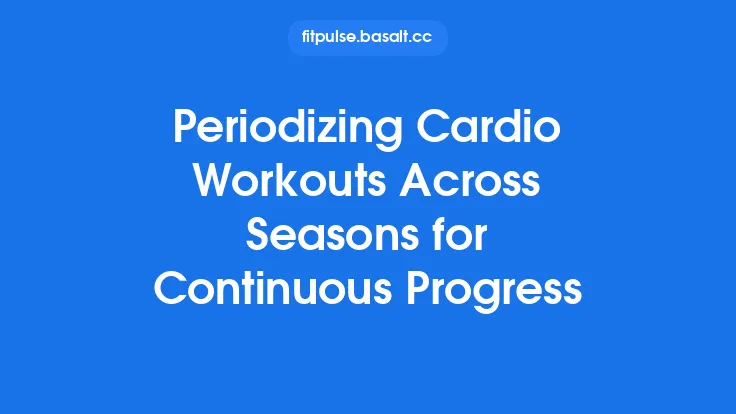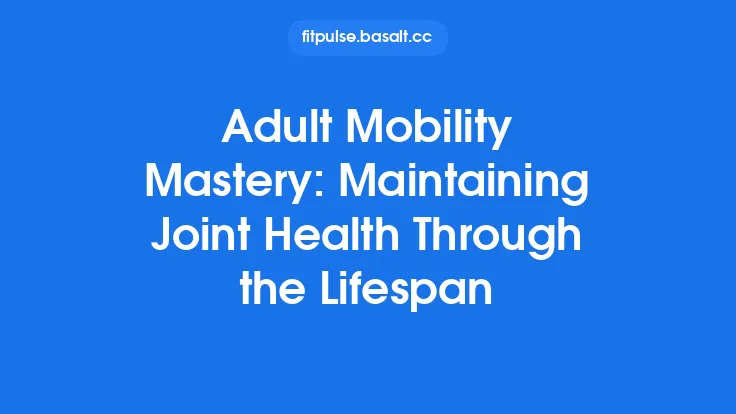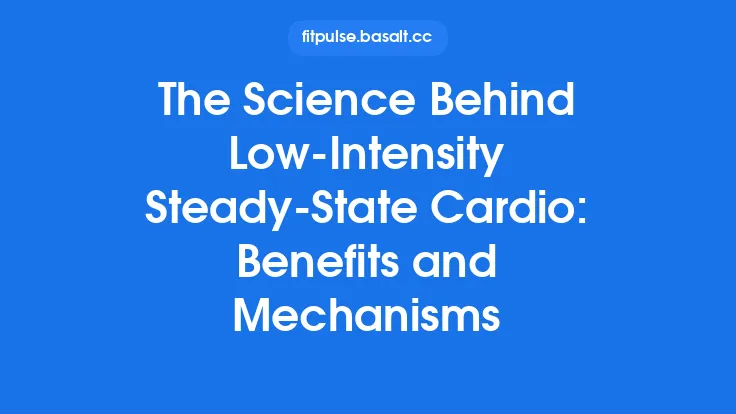Maintaining a healthy heart is not a short‑term project; it is a lifelong partnership between the body, the mind, and the choices we make each day. While a single burst of cardio can boost fitness temporarily, true cardiac resilience is built through strategic, progressive, and adaptable aerobic conditioning that evolves with every stage of life. Below is a comprehensive roadmap that outlines how to design, implement, and sustain cardio practices that protect the heart from the inside out, from childhood through the golden years.
Understanding Cardiac Physiology and How Cardio Shapes It Over Time
The heart is a muscular pump whose performance is dictated by three core parameters: stroke volume (the amount of blood ejected per beat), heart rate (beats per minute), and cardiac output (stroke volume × heart rate). Regular aerobic exercise induces several physiological adaptations that enhance each of these components:
| Adaptation | Mechanism | Long‑Term Cardiac Benefit |
|---|---|---|
| Increased Stroke Volume | Expansion of left‑ventricular chamber size and improved myocardial contractility | The heart can deliver more oxygen with fewer beats, reducing overall workload. |
| Lower Resting Heart Rate | Enhanced vagal tone and efficient autonomic balance | A lower baseline rate reflects a more efficient heart and is linked to reduced mortality. |
| Improved Endothelial Function | Shear stress from blood flow stimulates nitric oxide production | Vessels remain flexible, lowering the risk of atherosclerotic plaque formation. |
| Enhanced Mitochondrial Density | Repeated aerobic stimulus upregulates mitochondrial biogenesis | Muscles (including cardiac muscle) become more efficient at using oxygen. |
| Elevated VO₂max | Greater oxygen extraction capacity of the circulatory system | Higher aerobic capacity provides a larger “reserve” for stressors such as illness or injury. |
Understanding these mechanisms helps you appreciate why a well‑structured cardio regimen is more than a calorie‑burning tool—it is a direct stimulus for cardiac remodeling that protects against age‑related decline.
Age‑Specific Cardio Considerations – From Youth to Senior Years
1. Childhood & Adolescence (≈ 5‑18 years)
- Goal: Establish movement habits and develop a robust aerobic base.
- Key Points:
- Emphasize play‑based activities (e.g., tag, swimming, cycling) that naturally raise heart rate to 60‑80 % of age‑predicted maximum.
- Focus on skill acquisition and enjoyment rather than structured intensity.
- Monitor growth spurts; rapid height changes can temporarily affect coordination and perceived exertion.
2. Early Adulthood (≈ 19‑35 years)
- Goal: Consolidate aerobic capacity while integrating cardio into a busy lifestyle.
- Key Points:
- Introduce periodized training blocks (e.g., 4‑6 weeks of moderate volume, followed by a 1‑week recovery phase).
- Begin incorporating higher‑intensity intervals (e.g., 30 seconds at 85‑90 % HRmax) to stimulate VO₂max improvements.
- Use heart‑rate variability (HRV) tracking to fine‑tune recovery needs.
3. Midlife (≈ 36‑55 years)
- Goal: Counteract the natural decline in maximal heart rate (~1 bpm per year) and preserve ventricular compliance.
- Key Points:
- Shift emphasis toward longer steady‑state sessions (45‑60 minutes) at 65‑75 % HRmax to maintain stroke volume.
- Add “cardio‑strength” hybrids (e.g., rowing, elliptical with resistance) to support muscular endurance and joint health.
- Schedule annual cardiac screening (e.g., resting ECG, lipid panel) to detect early changes.
4. Senior Years (≥ 56 years)
- Goal: Sustain functional capacity, protect against arrhythmias, and maintain autonomic balance.
- Key Points:
- Prioritize moderate‑intensity continuous training (MCT) at 55‑70 % HRmax, with occasional low‑impact intervals to keep the heart responsive.
- Incorporate “active recovery” days (e.g., brisk walking, light cycling) to promote circulation without excessive strain.
- Pay close attention to signs of overtraining (persistent fatigue, elevated resting heart rate) and adjust volume accordingly.
Building a Periodized Cardio Program for Lifelong Heart Health
Periodization is the systematic planning of training variables (intensity, volume, frequency) to elicit optimal adaptations while minimizing injury risk. A macrocycle (annual plan) can be broken down into mesocycles (4‑8 weeks) and microcycles (weekly). Below is a flexible template that can be customized for any age group:
| Phase | Duration | Primary Focus | Typical Intensity (HR%max) | Sample Sessions |
|---|---|---|---|---|
| Foundation | 4‑6 weeks | Build aerobic base, improve stroke volume | 60‑70 % | 30 min steady jog, 45 min swim |
| Development | 4‑6 weeks | Increase VO₂max, enhance cardiac output | 70‑85 % (including intervals) | 4×4 min intervals at 85 % with 2 min recovery |
| Peak | 2‑4 weeks | Maximize cardiovascular efficiency | 80‑90 % (shorter, high‑intensity bursts) | 10×30 sec sprints with 90 sec active rest |
| Recovery | 1‑2 weeks | Consolidate gains, reduce fatigue | 50‑60 % (active recovery) | Light cycling, easy walking |
Key Principles
- Progressive Overload: Gradually increase either duration or intensity each mesocycle, never both simultaneously.
- Individualization: Adjust based on HRV, perceived exertion, and any medical feedback.
- Deload Weeks: Incorporate a low‑volume week every 4‑6 weeks to allow cardiac remodeling without overstress.
- Cross‑Training: Rotate modalities (running, rowing, swimming) to challenge the heart from different angles and reduce repetitive strain.
Selecting the Right Modalities for Sustainable Cardiac Conditioning
While the ultimate goal is heart health, the choice of activity influences adherence, joint stress, and specific cardiac stimuli. Below are common aerobic modalities and the cardiac profile they emphasize:
| Modality | Cardiac Stress Pattern | Joint Impact | Typical Session Length |
|---|---|---|---|
| Running / Jogging | High peak heart rate, strong impact on stroke volume | Moderate‑high (especially on knees) | 20‑60 min |
| Cycling (road or stationary) | Steady heart rate elevation, good for VO₂max | Low (non‑weight‑bearing) | 30‑90 min |
| Rowing | Simultaneous upper‑ and lower‑body demand, high cardiac output | Low‑moderate (smooth motion) | 20‑45 min |
| Swimming | Full‑body aerobic stimulus, excellent for cardiac output | Minimal (buoyancy reduces stress) | 30‑60 min |
| Elliptical / Cross‑Trainer | Consistent heart rate, moderate intensity | Low (gliding motion) | 30‑60 min |
| Hiking (incline walking) | Variable heart rate due to terrain, promotes stroke volume | Low‑moderate (depends on terrain) | 45‑120 min |
Choosing for Longevity
- Variety prevents monotony and distributes mechanical load across different musculoskeletal structures.
- Accessibility ensures you can maintain the habit even when travel or life changes occur.
- Safety: For individuals with known cardiac conditions, low‑impact options (cycling, swimming) are often recommended by clinicians because they allow precise heart‑rate control without excessive joint stress.
Monitoring Progress – Objective Metrics and When to Adjust
Long‑term success hinges on data‑driven feedback. The following metrics provide a clear picture of cardiac health and training effectiveness:
- Resting Heart Rate (RHR)
- Measured first thing in the morning, before caffeine.
- A gradual decline (2‑5 bpm) over months signals improved cardiac efficiency.
- Sudden increases (> 5 bpm) may indicate overtraining or illness.
- Heart‑Rate Variability (HRV)
- Captured via chest strap or validated wrist device.
- Higher HRV reflects robust parasympathetic tone; a consistent downward trend warrants a training load reduction.
- VO₂max Estimation
- Use submaximal field tests (e.g., Cooper 12‑minute run) or wearable‑derived algorithms.
- Aim for a 5‑10 % improvement every 6‑12 months, plateauing as you approach age‑adjusted norms.
- Recovery Heart Rate
- Record the drop from peak to 1‑minute post‑exercise. Faster recovery indicates better cardiovascular fitness.
- Subjective Measures
- Rate of Perceived Exertion (RPE): Keep sessions within the target RPE band (e.g., 3‑5 for moderate, 6‑7 for high intensity).
- Energy Levels & Mood: Persistent fatigue or mood swings may signal insufficient recovery.
Adjustment Triggers
- RHR ↑ > 5 bpm for > 3 days → Reduce volume by 10‑20 % or insert an extra recovery week.
- HRV ↓ > 15 % from baseline → Prioritize low‑intensity sessions and sleep hygiene.
- VO₂max stagnation for > 6 months → Introduce new interval structures or increase session frequency modestly.
Integrating Cardio with Preventive Healthcare Practices
Cardio does not exist in isolation; its benefits are amplified when paired with routine medical care and lifestyle safeguards:
- Annual Cardiovascular Screening
- Resting ECG, lipid profile, and blood glucose testing help identify silent risk factors that may influence cardio intensity.
- Discuss any abnormal findings with a healthcare provider before escalating training load.
- Vaccinations & Illness Management
- Maintaining immunity (e.g., flu vaccine) reduces the likelihood of infection‑related cardiac strain.
- During acute illness, adopt the “neck‑check” rule: if symptoms are above the neck (runny nose, mild sore throat), light cardio may be permissible; otherwise, rest.
- Medication Awareness
- Beta‑blockers, calcium channel blockers, and certain anti‑arrhythmics blunt heart‑rate response. Adjust target HR zones accordingly (e.g., use perceived exertion or power output instead of HR).
- Discuss any new cardio regimen with your physician if you are on cardiac medications.
- Sleep Hygiene
- While not a primary focus of this article, adequate sleep (7‑9 hours) supports autonomic balance and HRV, indirectly enhancing cardio outcomes.
Managing Common Barriers and Maintaining Motivation Across Decades
Even the most scientifically sound program can falter without strategies to overcome real‑world obstacles:
| Barrier | Practical Solution |
|---|---|
| Time Constraints | Adopt “micro‑sessions” (e.g., three 10‑minute bouts) that add up to a full workout; use commute time for active transport. |
| Seasonal Weather | Invest in indoor alternatives (treadmill, stationary bike) or join a community indoor cycling class. |
| Travel | Pack a resistance band and a jump rope; use hotel gyms or explore local parks for walking/running routes. |
| Motivation Dips | Set process‑oriented goals (e.g., “complete 3 cardio sessions per week for 4 weeks”) rather than outcome‑only goals. Celebrate milestones with non‑food rewards. |
| Health Setbacks | Follow a “return‑to‑cardio” protocol: start with 50 % of previous volume, increase by 10 % each week, and monitor RHR/HRV closely. |
| Social Isolation | Join virtual cardio challenges, use fitness apps with community leaderboards, or schedule “cardio dates” with friends or family. |
The Role of Technology and Data‑Driven Insights in Long‑Term Cardio Planning
Modern wearables and health platforms have transformed how we track and adapt cardio training:
- Continuous Heart‑Rate Monitoring
- Chest‑strap sensors provide the most accurate HR data, essential for staying within prescribed zones.
- Many devices now integrate HRV analysis directly into daily dashboards.
- Smartphone‑Based VO₂max Estimators
- Algorithms use GPS speed, elevation, and HR data to approximate VO₂max after a standard run or walk.
- Regular re‑testing (quarterly) offers a clear view of aerobic trends.
- Training Load Calculators
- Platforms like TrainingPeaks or Strava compute Training Stress Score (TSS), allowing you to balance high‑intensity and low‑intensity work over weeks.
- Aiming for a TSS “sweet spot” of 400‑600 per week for most adults promotes adaptation without overreaching.
- Remote Cardiac Monitoring
- For individuals with known cardiac conditions, FDA‑cleared devices (e.g., KardiaMobile) can detect arrhythmias during or after workouts, prompting timely medical review.
- Data Visualization
- Graphing RHR, HRV, and VO₂max side‑by‑side over months reveals patterns that simple weekly logs miss.
- Use these visuals during physician visits to discuss progress and adjust medical recommendations.
Caveat: Technology should augment, not replace, clinical judgment. Always verify device accuracy and discuss any concerning trends with a healthcare professional.
Putting It All Together
A heart‑healthy cardio strategy that endures across the lifespan is built on three pillars:
- Physiological Insight – Knowing how aerobic work remodels the heart guides the selection of intensity, duration, and frequency.
- Structured Periodization – A flexible, age‑adjusted plan that cycles through foundation, development, peak, and recovery phases ensures continuous adaptation while safeguarding against overuse.
- Feedback Loop – Regular monitoring of objective metrics (RHR, HRV, VO₂max) combined with preventive healthcare and technology creates a responsive system that evolves with you.
By embracing these principles, you transform cardio from a fleeting workout into a lifelong, heart‑protective habit—one that keeps the pump strong, the vessels supple, and the rhythm steady, no matter what chapter of life you’re in.
